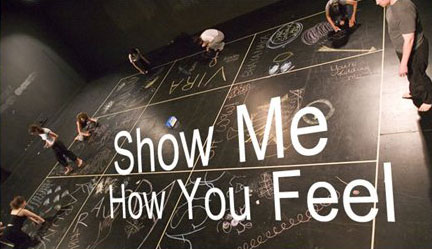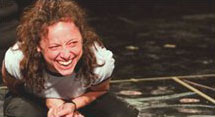 |
| |
|
Rasaboxes
Summer Weekend
Intensive
July 10 - July 12 |
 |
|
|
| |
|
|
| |
| |
| Become
an Athlete of the Emotions |
Rasabox Training
Weekend Intensive
July
10th - July 12th
MASTER TEACHER
Michele Minnick |
Participants will be thoroughly introduced to
theory and practice of the RasaBoxesTM exercises, devised by Richard Schechner.
Participants will learn to embody eight basic emotional-energetic states (rasas)
via the breath, body and voice, and explore the various ways of working with
the rasas to create performance work.
Rigorous daily training includes hatha yoga, extensive breath and voice and movement
work. We will work with various somatosensory techniques and principles including
those derived from pranayama, Richard Schechner, Michael Chekhov, LabanIBartenieff,
Bioenergetics, Lecoq and others. Participants will develop performance compositions
based on the RasaBoxes material.
The workshop is designed to accommodate a range of skill levels and interests
of professionals and students, from actors and directors to drama, movement,
and dance teachers and therapists,
performance artists, musicians, choreographers, playwrights and others. |
| |
Weekend
Intensive!!!
Friday 6-9pm, Saturday & Sunday 10-5pm
Cost $250.00
Space is limited, so please register now!!!
Note: (This workshop is not closed for Registration!.
Please send us an email if you are interested in our upcoming workshops this
fall!!)
To register call: 212 736-3309 or
email:ams@actorsmovementstudio.com
Please include following information in your email.
Name :
Phone:
Workshop: weekend or 8 day
|
| |
Michele Minnick, CMA, MA, is a performer, director,
teacher and writer. Her approach to performer training combines her expertise in Laban movement analysis with Environmental Theatre techniques and principles
from performance disciplines including postmodern dance, experimental theatre,
performance art, the somatic arts, and expressive arts therapies. She has served
on the faculty of the Laban/Bartenieff Institute of Movement Studies in New York
City, served for several years as co-director of education for East Coast
Artists (under Artistic Director Richard Schechner), and taught the Performance
Workshop with East Coast Artists at New York University from 1999-2007, in
recent years also training new teachers of the work. A primary developer and
teacher of rasaboxes, Michele has integrated her LMA/BF training with rasaboxes
and other Environmental Theater and performance techniques in workshops in the
U.S., Brazil, and elsewhere. She has presented the rasaboxes work in lecture
demonstrations and workshops at international festivals and conferences in
Turkey, Serbia, Canada, Brazil and the U.S. She has worked closely with Paula
Murray Cole, co-teaching and developing the work, and co-authored the article,
“The Actor As Athlete of the Emotions: The RasaBoxes Exercise”, for the book
Movement For Actors, edited by Nicole Potter, Allworth Press, 2002. Michele is
an associate member of the International Society for Research on Emotion, is a
client and student of Reichian analysis, and is completing her doctoral thesis
at New York University, a theoretical project on performance and healing in the
art/life practices of Leeny Sack, Lygia Clark, and Anna and Daria Halprin. For
the 2008-2009 academic year, she is teaching as a guest artist in the MFA and
undergraduate theatre departments at Towson University in Maryland. |
|
|
|
| |
|
| |
 |
| Paula
Murray Cole |
 |
| |
 |
| |
| To contact us |
Phone:
212-736-3309
E-mail: ams@actorsmovementstudio.com |
Actors Movement Conservatory
PO Box 1098
New York, NY 10018 |
|
 |
Paula Murray Cole '87 teaches actors
using a
method based on an ancient Sanskrit theory.
by Zachary Loeb '06 |
 |
| |
| Paula Murray Cole formerly co-director of education for East
Coast Artists and an instructor forthe ECA Summer Workshop at New York University,
Tisch School of the Arts. She has taught at Ithaca College, Dell' Arte International
School for Physical Theatre, the University of Illinois, Interlochen National
Arts Camp, and the and has conducted workshops at The University of Tennessee,
Dartmouth, Cornell, Concordia University, Montreal and Ege University in Izmir,
Turkey. As a professional actor and director, her credits include work with the
Houston and the Dallas Shakespeare Festivals, The Alley Theatre, The Lark Theatre,
New York Theatre Workshop, with East Coast Artists, Arden Party and the Phone
Booth Theatre Company in the Netherlands. Publications: "The Actor as Athlete
of the Emotions: The Rasaboxes Exercises", Movement for Actors, edited by
Nicole Potter, Allworth Press, 2002; and as a contributing writer for "Rasaesthetics",
by Richard Schechner, Performance Theory, Routledge Classics, 2003. She holds
an MFA in Acting from SMU and a BFA in Acting from Ithaca College. When preparing a meal, the chef must think not only of the ingredients
but also of how to prepare them, how the flavors will mix, how to best cook them,
and how to present the dish most appealingly. In the same way that a culinary
school would teach aspiring chefs, the RasaBoxesTM exercises seek to train actors
-- to treat each emotion as an ingredient to be fully taken in by the actor,
so that its flavor can be tasted and digested by the audience. One of the main
movers behind this unusual technique is Paula Murray Cole 87, a visiting assistant
professor of acting at IC.
After graduating from Ithaca, Paula earned her M.F.A. in acting at the Meadows
School of the Arts. She has worked as an actor and director and led workshops
at many venues around the country and abroad. She is the codirector of education
for East Coast Artists, a theater company headquartered at the New York University
Tisch School of the Arts. She is also one of the country's chief developers
and proponents of RasaBoxes.
The actor-training technique was adapted from a theory of emotion detailed in
an ancient Sanskrit manual on performance (circa sixth century BCE to second
century CE') called the Natyasatra. Pass, from the Sanskrit language, literally
means flavor, essence, or "juice." It also refers to specific "emotional
flavors" or states that are shared between performers and audience. There
are eight primary rasa states: sringara (desire, love), hasya (humor), karuna
(pity, grief), raudra (anger), vira (courage, energy), bhayanaka (fear, shame),
bibhatsa (disgust), and adbhuta (wonder). A ninth rasa, shanta (peace), was later
added to the Natyasastra's system of primary rasas. These emotional states, and
the way in which they mix and coexist, underlie all behavior.
In the RasaBoxes exercises, participants move through nine boxes of equal size
drawn on the floor (hence the "boxes" in "RasaBoxes"). Each
represents a rasa state, with shanta always in the middle. Participants spend
time I learning to embody each state. For Paula, what makes RasaBoxes so worthwhile
is that the technique "integrates rather than separates acting, voice, and
movement."
The RasaBoxes method also incorporates modern ideas such as those of French playwright,
actor, and directorAntonin Artaud, who demanded that actors be "athletes
of the emotions," capable of hopping in and out of a scene's needed sensibilities
with the same dexterity that an athlete uses when moving between the bench and
live action. The Natyasastra gives very specific instructions on the portrayal
of each emotion; RasaBoxes uses an improvisational approach that allows for each
actor's individual expression.
The roots may be ancient, but the RasaBoxes tree is vibrant. "Some of the
best theater I've seen," says Paula, "is [from] people going into RasaBoxes
forthe first time." The modern technique was developed in the early 1990s
by NYU theater professor Richard Schechner. Paula learned it directly from him
and since then has been a key player in the evolution of the exercises, along
with Michele Minnick, the associate artistic director and codirector of education
for East Coast Artists. "We have combined Richard's original exercises with
our own experience and knowledge," Paula says, "coming from acting
technique; movement analysis; voice, breath, and body work; and performance theory."
The rasa approach to emotions, she points out, can be seen in many other places,
including--surprisingly--neurobiology. "It's almost as if modern science
is just catching up with ideas contained in this ancient text," she says.
For example, she cites the work of Columbia University biology professor Michael
D. Gershon, whose research into the enteric (bowel) nervous system shows that
it can react based on its own impulses, instead of waiting for the brain to tell
it how to react. Thus the ancients' belief in "gut feelings" may be
grounded in reality.
This reinforces the rasa idea of emotion as happening independently of thinking,
of radiating from a human's core. Contemporary research into emotion suggests
that things such as the facial exe pression of emotion is universal--hard-wired
into our evolutionary mainframe. Whether you're from Greece, Canada, Tibet, Texas,
or Mexico, a smile is still a smile and a frown is still a frown. It is this
universality of
emotion that RasaBoxes taps.
IC theater arts professor Norm Johnson was among the first-time participants
at the recent RasaBoxes Training Intensive. Workshop held at Ithaca College this
summer. Although he had seen its positive effects upon freshmen who'd studied
with Paula, it took time for him to adjust to the technique's emphasis on emotion
rather than character. "On the surface it is almost polar to what I've been
taught and been practicing," he says. Yet he says now that RasaBoxes is "an
incredibly valuable tool"
for an actor.
In addition to holding workshops all over the country, Paula teaches RasaBoxes
to all incoming musical theater and acting majors at IC. But not all her students
are actors. Paula and her colleague Michele Minnick are developing a pilot program
for medical students, to better help them identify emotional cues being exhibited
by patients. She has shared RasaBoxes with drama therapists to show its potential
therapeutic applications. Landscape architect Maggie Daly, while working on her
master's degree at the University of Oregon, took part in a workshop, hoping
to "see what kind of form making would emerge." She plans to use the
RasaBoxes technique as she designs new works.
Paula has made extensive use of the technique as an actor herself. In playing
Ophelia in a production of Shakespeare's Hamlet, she "often used the rasa
karuna (pity/grief/ anguish/compassion)" to fully immerse herself in the
role. A description from her rehearsal notes reads: "My knees sink to the
ground, my belly tightens and rounds my spine/my throat tightens/my breath heaves/my
head bows.... The experience is as if it were happening to me; karuna is moving
me according to its demands. I am simply and cornplataly connecting with the
rasa." [box]
Before Cornrnon Era; Common Era |
|
|
| |
| |
|
|
|
|
|